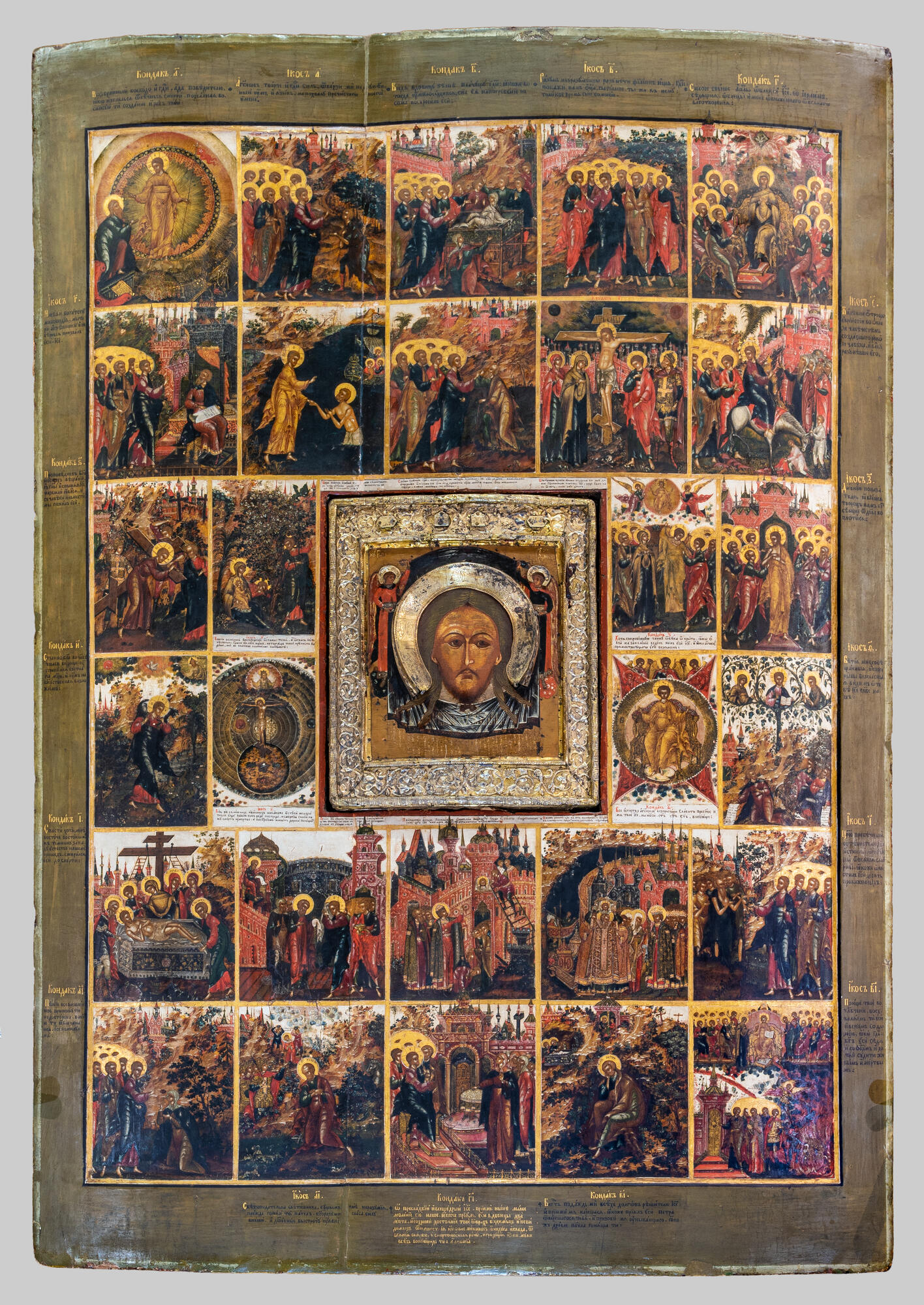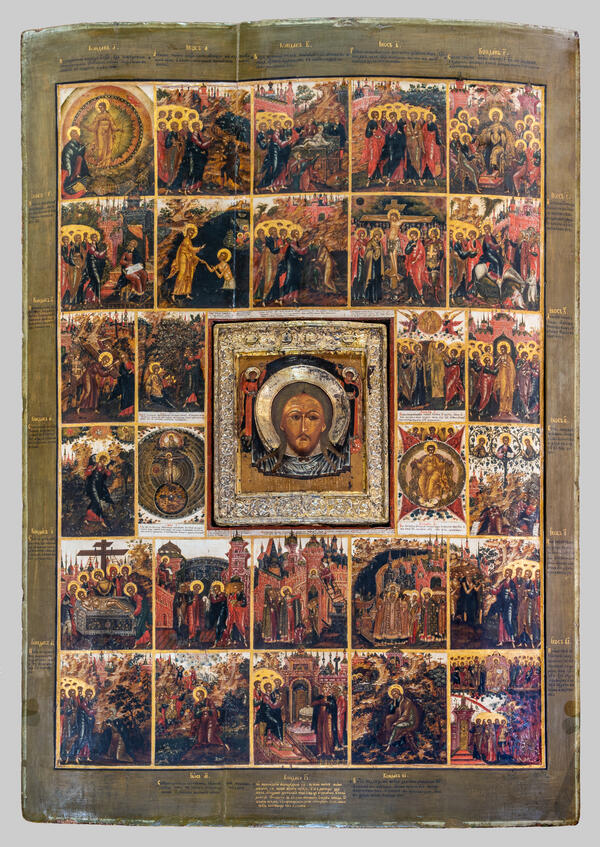The Akathist to the Savior Icon is considered one of the brightest examples of the Palekh style. It was created for the iconostasis of the Kazansky side chapel of the Exaltation of the Cross Church in the 1770s. The church itself was opened and consecrated in 1774.
The iconographer is unknown, but an old legend claims it was created by the face painter Ivan Balyakin and the dress painter Nikita Butorin. In Palekh, it was normal for several icon painters to work on the same icon. One of them would paint clothes, hence the name dress painter. The other one would depict the open parts of the body and the faces of saints, which earned him the name face painter.
The Palekh artists have freely outlined the unusual shapes of hills, plants, architectural spires, and turrets. The lines in the icon vary between clearly visible to almost blending with the white background.
With wide and precise strokes of the brush, the Palekh artists painted the details of the ornament, the gaps in rock-mounds, and the fine white lines. While the icon has many details, it does not feel overloaded. All the elements work well with the general background, blending with it to varying degrees. The artists managed to create the illusion of depth and show the closeness and remoteness of objects.
The icon’s centerpiece was created in the second half of the 16th century. It depicts the Mandylion in a metal frame with stamping. It was brought to Palekh from Veliky Ustyug. For the centerpiece not to look out of place, the Palekh iconographers painted the border scenes surrounding it in a similar style. The border scenes in an icon painting are small independent scenes around the centerpiece. The artists also introduced the story of the Mandylion into the overall composition: according to legend, the first image of Jesus appeared on a piece of fabric not through the work of an artist, but by miracle. It is believed that the Savior washed his face with water and wiped it with a cloth (towel), upon which his likeness was imprinted. That image became the first icon in history. The legend is told by three border scenes right under the centerpiece: the Application of the Holy Sudarium to the Face of Jesus, the Establishment of the Holy Sudarium over the City Gates, and the Relocation of the Holy Sudarium.
The central composition is also surrounded by 25 border scenes depicting the 25 verses of the Akathist to Our Sweetest Lord Jesus Christ. An Akathist Hymn is a church chant praising the Lord God, the Virgin Mary, or a saint. They are devoted to the main stages of the earthly life of the Savior. They tell about the Harrowing of Hell, the Healing a Deaf Mute, the Raising of the Son of the Widow of Nain, and other miracles.
The Akathist to the Savior Icon is considered the benchmark of the Palekh style. It is considered a real masterpiece of the Palekh artistic traditions and is rightfully seen as one of the best examples of the Russian religious painting tradition. Sophisticated architectural decorations with whitewash patterns and high hills with soft curves have become the hallmark of a traditional Palekh icon.
The iconographer is unknown, but an old legend claims it was created by the face painter Ivan Balyakin and the dress painter Nikita Butorin. In Palekh, it was normal for several icon painters to work on the same icon. One of them would paint clothes, hence the name dress painter. The other one would depict the open parts of the body and the faces of saints, which earned him the name face painter.
The Palekh artists have freely outlined the unusual shapes of hills, plants, architectural spires, and turrets. The lines in the icon vary between clearly visible to almost blending with the white background.
With wide and precise strokes of the brush, the Palekh artists painted the details of the ornament, the gaps in rock-mounds, and the fine white lines. While the icon has many details, it does not feel overloaded. All the elements work well with the general background, blending with it to varying degrees. The artists managed to create the illusion of depth and show the closeness and remoteness of objects.
The icon’s centerpiece was created in the second half of the 16th century. It depicts the Mandylion in a metal frame with stamping. It was brought to Palekh from Veliky Ustyug. For the centerpiece not to look out of place, the Palekh iconographers painted the border scenes surrounding it in a similar style. The border scenes in an icon painting are small independent scenes around the centerpiece. The artists also introduced the story of the Mandylion into the overall composition: according to legend, the first image of Jesus appeared on a piece of fabric not through the work of an artist, but by miracle. It is believed that the Savior washed his face with water and wiped it with a cloth (towel), upon which his likeness was imprinted. That image became the first icon in history. The legend is told by three border scenes right under the centerpiece: the Application of the Holy Sudarium to the Face of Jesus, the Establishment of the Holy Sudarium over the City Gates, and the Relocation of the Holy Sudarium.
The central composition is also surrounded by 25 border scenes depicting the 25 verses of the Akathist to Our Sweetest Lord Jesus Christ. An Akathist Hymn is a church chant praising the Lord God, the Virgin Mary, or a saint. They are devoted to the main stages of the earthly life of the Savior. They tell about the Harrowing of Hell, the Healing a Deaf Mute, the Raising of the Son of the Widow of Nain, and other miracles.
The Akathist to the Savior Icon is considered the benchmark of the Palekh style. It is considered a real masterpiece of the Palekh artistic traditions and is rightfully seen as one of the best examples of the Russian religious painting tradition. Sophisticated architectural decorations with whitewash patterns and high hills with soft curves have become the hallmark of a traditional Palekh icon.





